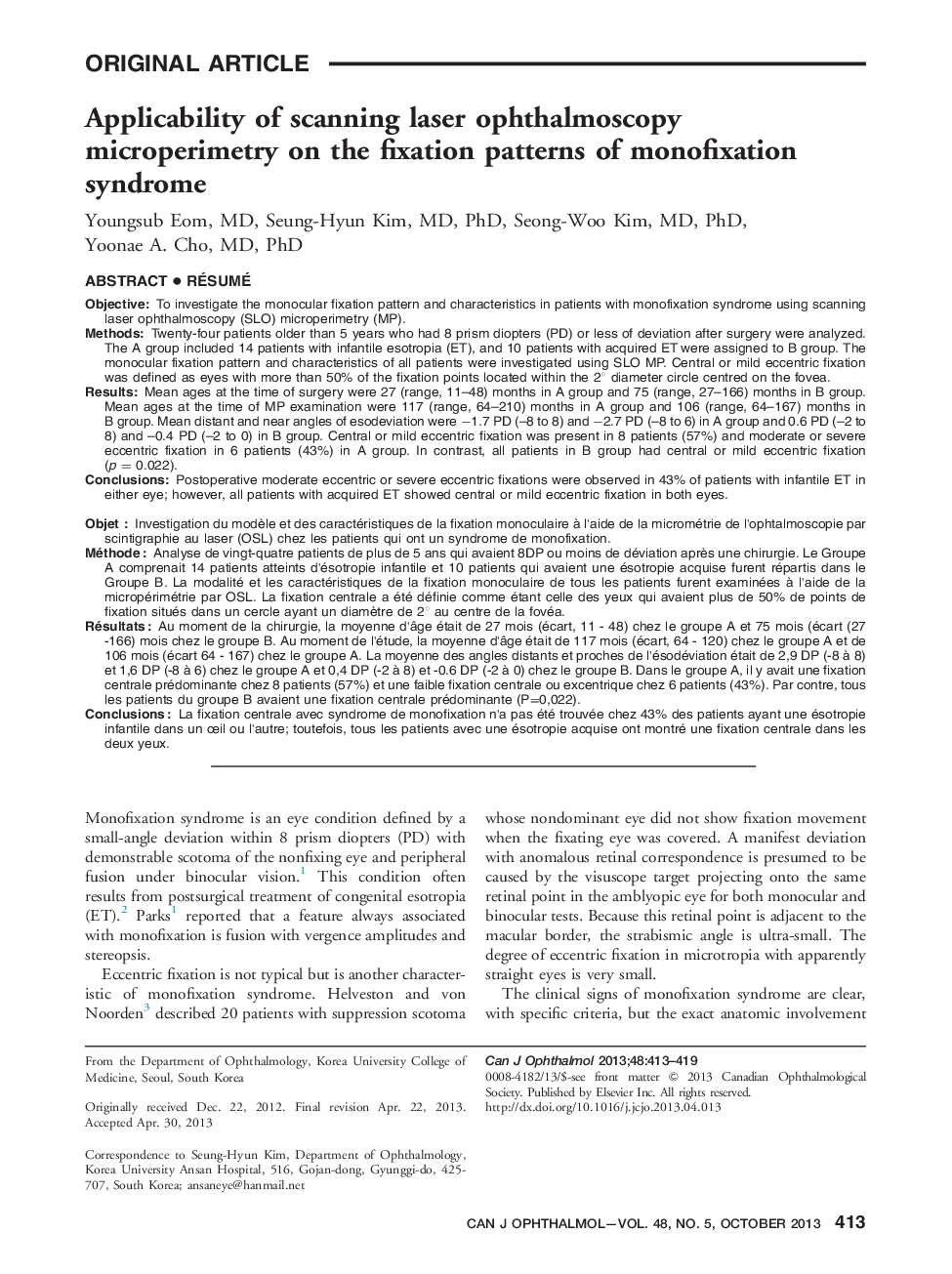| Article ID | Journal | Published Year | Pages | File Type |
|---|---|---|---|---|
| 4009467 | Canadian Journal of Ophthalmology / Journal Canadien d'Ophtalmologie | 2013 | 7 Pages |
ObjectiveTo investigate the monocular fixation pattern and characteristics in patients with monofixation syndrome using scanning laser ophthalmoscopy (SLO) microperimetry (MP).MethodsTwenty-four patients older than 5 years who had 8 prism diopters (PD) or less of deviation after surgery were analyzed. The A group included 14 patients with infantile esotropia (ET), and 10 patients with acquired ET were assigned to B group. The monocular fixation pattern and characteristics of all patients were investigated using SLO MP. Central or mild eccentric fixation was defined as eyes with more than 50% of the fixation points located within the 2° diameter circle centred on the fovea.ResultsMean ages at the time of surgery were 27 (range, 11–48) months in A group and 75 (range, 27–166) months in B group. Mean ages at the time of MP examination were 117 (range, 64–210) months in A group and 106 (range, 64–167) months in B group. Mean distant and near angles of esodeviation were −1.7 PD (–8 to 8) and −2.7 PD (–8 to 6) in A group and 0.6 PD (–2 to 8) and –0.4 PD (–2 to 0) in B group. Central or mild eccentric fixation was present in 8 patients (57%) and moderate or severe eccentric fixation in 6 patients (43%) in A group. In contrast, all patients in B group had central or mild eccentric fixation (p = 0.022).ConclusionsPostoperative moderate eccentric or severe eccentric fixations were observed in 43% of patients with infantile ET in either eye; however, all patients with acquired ET showed central or mild eccentric fixation in both eyes.
RésuméObjetInvestigation du modèle et des caractéristiques de la fixation monoculaire à l'aide de la micrométrie de l'ophtalmoscopie par scintigraphie au laser (OSL) chez les patients qui ont un syndrome de monofixation.MéthodeAnalyse de vingt-quatre patients de plus de 5 ans qui avaient 8DP ou moins de déviation après une chirurgie. Le Groupe A comprenait 14 patients atteints d'ésotropie infantile et 10 patients qui avaient une ésotropie acquise furent répartis dans le Groupe B. La modalité et les caractéristiques de la fixation monoculaire de tous les patients furent examinées à l'aide de la micropérimétrie par OSL. La fixation centrale a été définie comme étant celle des yeux qui avaient plus de 50% de points de fixation situés dans un cercle ayant un diamètre de 2° au centre de la fovéa.RésultatsAu moment de la chirurgie, la moyenne d'âge était de 27 mois (écart, 11 - 48) chez le groupe A et 75 mois (écart (27 -166) mois chez le groupe B. Au moment de l'étude, la moyenne d'âge était de 117 mois (écart, 64 - 120) chez le groupe A et de 106 mois (écart 64 - 167) chez le groupe A. La moyenne des angles distants et proches de l'ésodéviation était de 2,9 DP (-8 à 8) et 1,6 DP (-8 à 6) chez le groupe A et 0,4 DP (-2 à 8) et -0.6 DP (-2 à 0) chez le groupe B. Dans le groupe A, il y avait une fixation centrale prédominante chez 8 patients (57%) et une faible fixation centrale ou excentrique chez 6 patients (43%). Par contre, tous les patients du groupe B avaient une fixation centrale prédominante (P=0,022).ConclusionsLa fixation centrale avec syndrome de monofixation n'a pas été trouvée chez 43% des patients ayant une ésotropie infantile dans un œil ou l'autre; toutefois, tous les patients avec une ésotropie acquise ont montré une fixation centrale dans les deux yeux.
